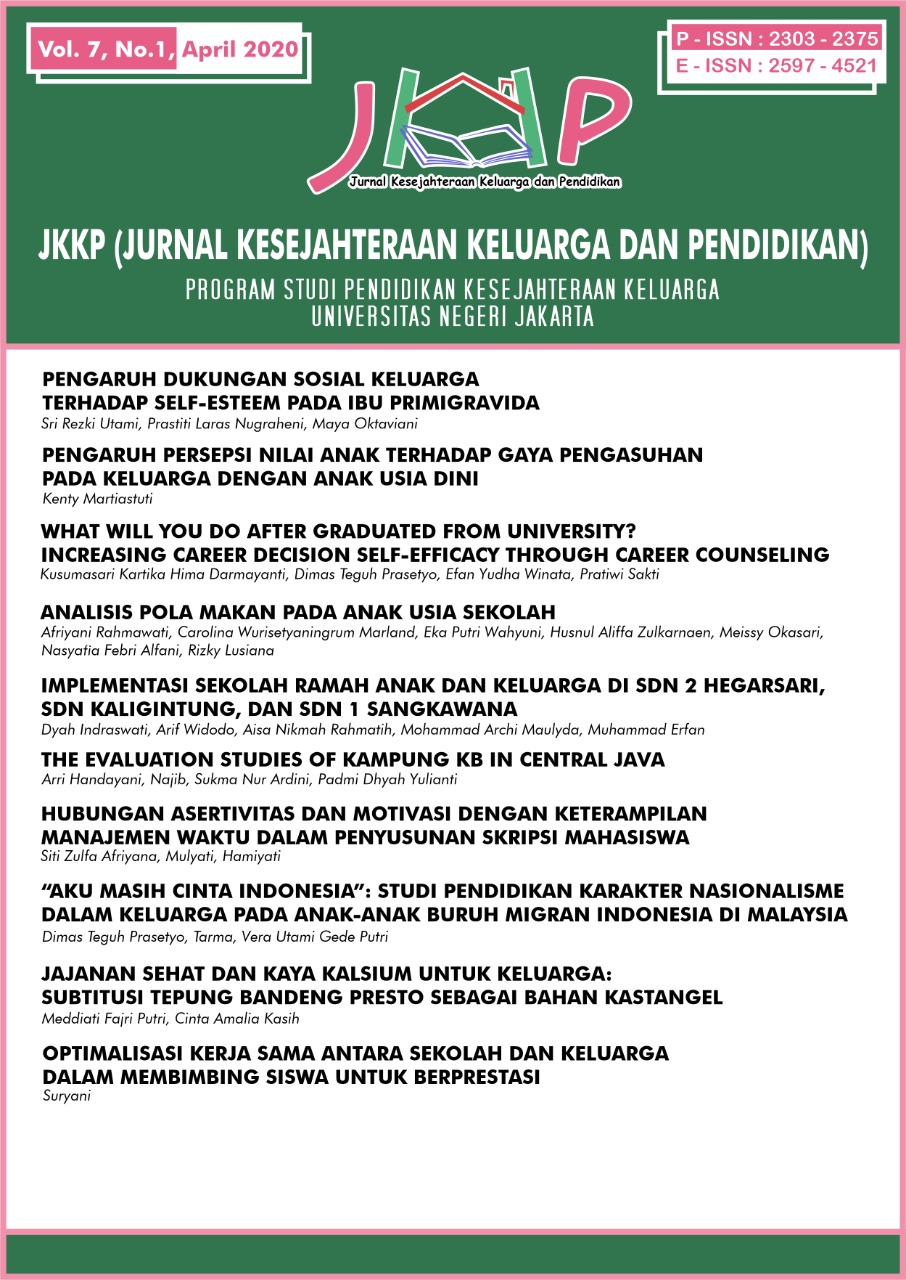ANALISIS POLA MAKAN PADA ANAK USIA SEKOLAH
DOI:
https://doi.org/10.21009/JKKP.071.04Keywords:
Eating Pattern, family involvement, healthy food, school aged childrenAbstract
Makanan yang dikonsumsi oleh anak usia sekolah sangat mempengaruhi perkembangan fisik. Orang tua memiliki peran untuk melakukan pengontrolan dan pengawasan terkait dengan pola makan anak karena anak usia sekolah rentan terkena penyakit terutama permasalahan gizi. Tujuan penelitian ini untuk mendeskripsikan dan menganalisis pola makan pada anak usia sekolah. Penelitian ini dilakukan pada bulan Desember 2019. Penelitian ini melibatkan 97 orang siswa di SDN Sumur Batu 01 Pagi Kemayoran, Jakarta yang dipilih dengan teknik stratified sampling. Pola makan diukur dengan menggunakan instrument The feeding practices and structure quistionnare (FPSQ) (Jansen, Mallan, Nicholson, & Daniels, 2014). Pola makan anak dilihat berdasarkan 8 dimensi, yaitu: dimensi ketidakpercayaan nafsu makan, hadiah untuk perilaku, hadiah untuk makan, makanan persuasif, pembatasan terselubung, pembatasan yang jelas, terstruktur pengaturan makan, dan terstruktur waktu makan. Pola makan anak dikategorikan menjadi 3 kategori, yaitu rendah, sedang, dan tinggi. Data yang telah dikumpulkan diolah dan dianalisis dengan menggunakan analisis deskriptif. Hasil penelitian menunjukkan bahwa 82,5 persen anak memiliki pola makan pada kategori sedang. Hasil ini menunjukan bahwa pola makan anak berada pada kategori belum optimal. Oleh karena itu, orang tua dan guru diharapkan dapat meningkatkan perhatian pada pola makan anak. Orang tua dan guru diharapkan dapat mengajarkan anak mengenai pola makan yang sehat.
Kata kunci: anak usia sekolah, keterlibatan keluarga, pola makan, makanan sehat
Analysis of Eating Pattern in School Aged Children
Abstrack
Food consumed by school age children greatly affects physical development. Parents have a role to the control and supervision related to child’s eating patterns because school age children vulnerable to disease, especially nutrition problems. The purpose of this study is to describe and analyze eating pattern in school age children. The research was conducted in december, 2019. This study involved 97 students at SDN Sumur Batu 01 Pagi Kemayoran, Jakarta that were selected using stratified sampling technique. Eating pattern have been measured using the feeding practices and structure questionnaire (FPSQ) instrument (Jansen, Mallan, Nicholson, & Daniels, 2014). Children's eating patterns were seen based on 8 dimensions, namely: distrust in appetite, reward for behavior, reward for eating, persuasive feeding, covert restriction, overt restriction, structured meal setting, and structured meal timing. Children's eating patterns are categorized into 3 categories, namely low, medium, and high. The data that has been collected is processed and analyzed using descriptive analysis. The results showed that 82,5 percent of children had a moderate eating pattern. These results indicate that children's eating patterns are still not optimal. Therefore, parents and teachers are expected to be able to increase attention to children's eating patterns. Parents and teachers are expected to be able to teach children about healthy eating patterns.
Keywords: eating pattern, family involvement, healthy food, school aged children
Downloads
Published
Issue
Section
License
Authors who publish with this Journal agree to the following terms:
- Author retain copyright and grant the journal right of first publication with the work simultaneously licensed under a creative commons attribution licensethat allow others to share the work within an acknowledgement of the work’s authorship and initial publication of this journal.
- Authors are able to enter into separate, additional contractual arrangementfor the non-exclusive distribution of the journal’s published version of the work (e.g. acknowledgement of its initial publication in this journal).
- Authors are permitted and encouraged to post their work online(e.g. in institutional repositories or on their websites) prior to and during the submission process, as it can lead to productive exchanges, as well as earlier and greater citation of published works.
Users/public use of this website will be licensed to CC BY SA
![]()







